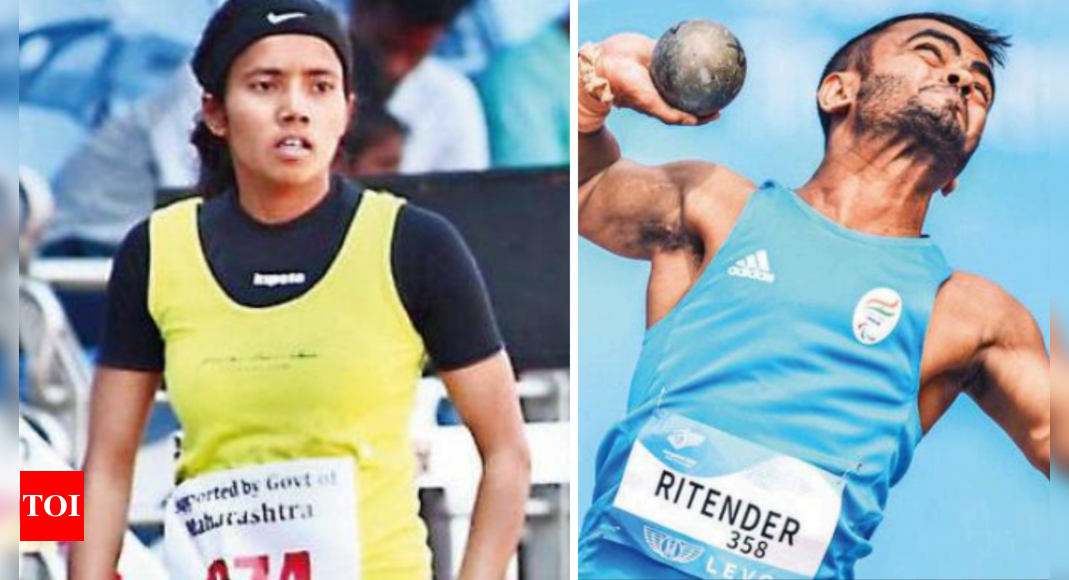[ad_1]
As India won a record 111 medals at the Asian Para Gamesin China, Preeti, 23, missed out by a whisker. Resolve almost took her to a medal in both the 100 and 200m races (T35 category) at Hangzhou.In the 100m sprint, she lost out on a medal by 0.14 seconds and in the 200m by 0.25 seconds.
Preeti wishes she had the training to make up those milliseconds. Pal’s, say coaches, is the story of many para-athletes who, with the right training and guidance, can give India a much richer medal haul.
For Preeti, who was diagnosed with cerebral palsy when she was young, it was impossible to travel regularly to Delhi’s Jawaharlal Nehru stadium from Meerut. A synthetic track, coaches and the right environment – the stadium has everything a sportsperson needs, but it’s also the only one of its kind in the region.
Preeti had no option but to train at the Kailash Prakash stadium in her hometown. “This fourth position was mainly because of the unavailability of synthetic tracks. The first time I ran on this format, I couldn’t get a grip of it,” she told TOI over a call.
Similar to Pal, 41-year-old Suvarna Raj made it to the top 8 in discus and shot put (54kg category) in Hangzhou. Suvarna said she had to run from pillar to post to get a place to practice in Noida.
Infra challenges add to para-athletes’ woes
In Greater Noida, where she lives, Raj said she couldn’t afford the Rs 11,000 daily charges needed to access the facilities. “I eventually trained at the Gautam Buddha University ground, which doesn’t have a track, but at least it was a place to practice in,” she said.
Coaches said getting access to international-level facilities is particularly difficult for para-athletes, mainly because of cost and distance – the latter a problem that can be solved by building more training centres in semi-urban and rural areas that are in tune with the country’s ambitions of showcasing itself as a sporting nation in the international arena and the Prime Minister’s stated desire of bidding to host the 2036 Olympics. “The only good training ground in Delhi-NCR is JLN stadium. Most paraathletes live in rural areas and belong to economically weaker sections, so they can’t afford training in the region, get proper equipment and keep up the diet needed for a professional sport. Every para-athlete also needs to be trained in a unique way, keeping in mind their individual physical challenge. There aren’t enough coaches who know how to train para-athletes either,” said Satyapal Singh, a coach.
One of his wards from Jewar, Praveen Kumar, won gold in high jump in Hangzhou. Singh trains around 40 para-athletes at his centre, Target Olympic Sports Academy (TOMSA), in Delhi. Pradeep Rai, secretary of the Association of Disabled People, said para-athletes should not have to win medals before governments start paying attention to their abilities and provide better infrastructure for them. Tripti Rajput solved the distance problem by managing to relocate to a place near JLN stadium but was saddled with a grave financial one.
The 19- year-old moved from her home in Tigri village of Greater Noida to Delhi’s South Extension so she could get better training, but her expenses now come to Rs 20,000 a month. “My family doesn’t have any financial backup. I am aiming to win gold in long jump (T46) at the 2024 Paralympic Games, so I can get a grant or a cash award to sustain myself,” she said. Rajput lost function in her left hand after an electric shock in 2013. “I was shattered. I loved sports since I was a kid and thought I would never be able to play again… I tried to train in Noida with a general coach, but that didn’t help. It was only then that I was forced to move to Delhi,” she said.
Singh, who is also training Tripti, said not everyone can shoulder the weight of this burden and he helps in whatever manner he can. “Some of the para-athletes stay at my home. I don’t charge anything from those who can’t afford it. Once they win medals and cash awards, they donate some amount to my centre. That’s how it is running,” he said.
Ritender Sehrawat’s father took a loan of Rs 2 lakh to ensure the 19-yearold with dwarfism could travel from their house in Najafgarh to the JLN stadium in Delhi in cabs and buy shot put equipment. Unable to keep up with this 60km two-way commute daily, Ritender shifted to a place near the stadium in 2021. Congratulating the Indian contingent’s impressive show in Hangzhou, winning 29 gold, 31 silver and 51 bronze medals and ranking fifth among participating countries, Union sports minister Anurag Thakur on Saturday credited it to the central government’s initiatives like Khelo India and an increase in budgetary allocations. Among the athletes who won gold was Neeraj Yadav (39).
The discus throw (55kg) champion said para-athletes in the country need a lot more support than what they currently get, including monthly allowance. Rajkumari, who won gold in powerlifting, for instance, gives private tuitions at her rented home in Delhi’s Chhatarpur to fund her training expenses. She had earlier told TOI she receives no aid except a disability pension of Rs 2,500 a month. “Top players get Rs 50,000 as allowance, but not everyone. Governments should support their training if any sportsperson is representing the country. Coaches should be awarded too,” said Neeraj, adding even he struggled to keep up his passion. “I would train at JLN stadium and then travel to Vasant Vihar to work as a vocational trainer at a hospital. Despite our challenges and our success not many para-athletes like us get jobs,” he said.
[ad_2]
Source link


